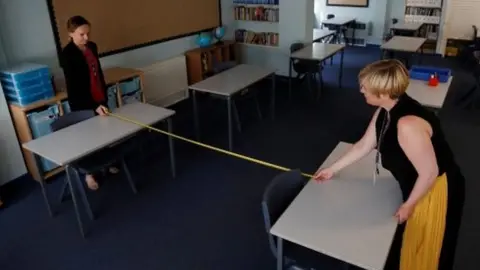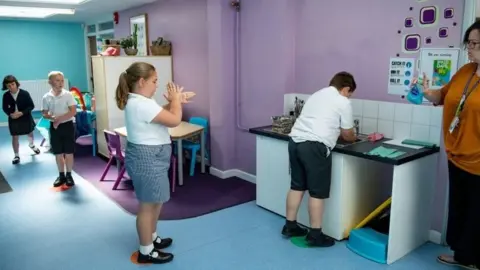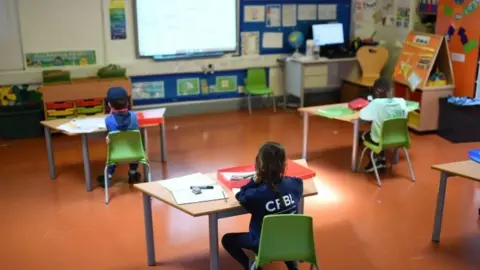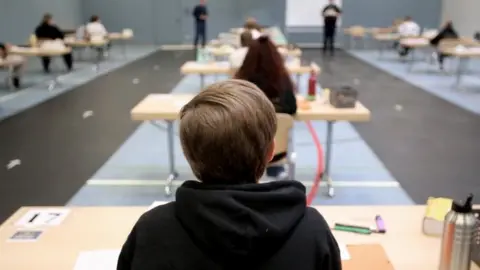Coronavirus: How will schools in Wales reopen?
 Reuters
ReutersWales is moving towards reopening schools for the first time since the lockdown restrictions came into force in March.
Education is devolved so the decision rests with the Welsh education minister.
All pupils will be able to return for limited periods during the week from 29 June - but only a third of pupils would be allowed into school at any time.
Here are a few of the main questions answered, from what we know so far:
What is the Welsh Government's thinking about children going back to school?
The Welsh Government had made clear they had an "ambition" for some pupils to return before the summer break in mid-July and this gives a taste of school for all pupils before September.
The message is now: "Check in, catch up, prepare for summer and September" with a stress on the importance of pupils' wellbeing, being able to get back into something of a routine and see friends.
It says teachers should not try to "catch up" on everything but have a clear focus on preparing children to learn again, when there would be a blend of "'in school' and 'out of school' learning driven by a single curriculum".
"We will use the last weeks of the summer term to make sure pupils, staff and parents are prepared - mentally, emotionally and practically - for the new normal in September," said Education Minister Kirsty Williams.
But she was also conscious about the loss of schooling already and said waiting until September would be "detrimental to the wellbeing, learning progress and mental health of our young people".
Is there much difference to what is happening in England?
Some pupils returned to primary school in England from 1 June but the move proved controversial - and there was a "highly variable" level of attendance and plans for all to open before the summer have now been dropped
Nursery, reception, Year 1 and Year 6 children were first to go back in England - but the Welsh Government is looking to give all pupils a taste before the summer.
Schools in Wales will have a brief return until the break-up for the summer holidays on 24 July.
Which schools are going back?
At least three-quarters of Wales' state schools are only returning for three weeks from 29 June.
It follows talks with unions, councils and government stalling.
David Evans, secretary for the National Education Union Cymru, said the fourth week was for teachers to work on a voluntary basis.
"It is up to local authorities about their decisions to open on the fourth week, taking account of their local circumstances and the challenges of wider opening, as you would expect.
"We know our members have been working hard to try and get as many children back to school in the weeks after 29 June."
What is the actual risk to children?
 PA Media
PA MediaThe risk of coronavirus to pupils in the classroom is "very, very small, but not zero", according to UK government's scientific advisory group Sage.
Risk expert Prof Sir David Spiegelhalter, of Cambridge University, told the BBC in May: "Based on the data so far there have been extremely low risks to children.
"Out of seven million five to 14-year-olds in England and Wales, so far there has been one death with covid marked on the death certificate.
"Now there will be more but it's still an unbelievably low risk. And we must remember this group of kids are staggeringly safe in general - less than one in 10,000 die every year. I don't think any [group] has been safer in the history of humanity."
Sage has said the role of children in the transmission of Covid-19 was uncertain, while Prof Spiegelhalter also urged caution about claims that children could spread infection, as some of the evidence presented so far had been weak.
A study by the University of Edinburgh and the Usher Institute said there was a risk of transmission by infected children, although there was no evidence of children being a main source of infection.
The Welsh Government's scientific advisory group Tac issued a briefing saying how staggered returns of smaller classes had the benefit of reducing transmission "if groups do not mix (including staff), but this requires more analysis".
It went on to say: "Staff and parents will also be directly impacted; it is probable that opening of schools will increase transmission in these groups. Any relaxation of closures will also need to consider how to reduce risk from the potential mixing of adults at school gates, in the staff room etc, and have protocols in place for vulnerable groups."
Schools are being asked to carry out a risk assessment for Covid-19 to identify "sensible measures to control the risks" but for paperwork to be kept to a minimum.
Ministers say more details will be developed in the autumn, while taking account of the latest scientific advice.
How might classrooms look?
 Getty Images
Getty ImagesWith fewer pupils going into school at any one time, it will make it easier to re-arrange classrooms with fewer desks. The idea is that although classes will be smaller - and children confined to their group - that allows for more intensive teaching, followed by more online learning at home.
The Welsh Government's promise is "much smaller classes, providing secure dedicated time with teachers and classmates".
"This time will include online and personalised classroom experience, getting children and teachers ready for a similar experience in September."
It also wants to "maximise the time learners spend outdoors", which it sees as having both learning and health benefits, particularly as the risk of infection is believed to be reduced outdoors, while social distancing is easier to manage.
Schools have also been asked to think of using temporary buildings or additional spaces nearby such as local community buildings.
How will schools manage if there are smaller class sizes?
Staffing is a concern for headteachers if they have to split classes into smaller groups. They are worried that some staff may not be available because they are shielding or may have children they have to care for and who may not be among the groups returning to school. Classroom space is another issue.
This may not be a problem with groups of children in school at different times, but the education minister has indicated they are looking at options to increase the space available to schools by using other buildings such as village halls or leisure centres.
Schools are being asked to think about whether a third of pupils attend for a week or over a three-week cycle.
They might be asked to attend in blocks or cohorts, such as a different group of learners each week. But the guidance says it does not necessarily need to be decided by year groups so it means children from the same household can attend at the same time.
What other safeguards might need to be in place?
There have been issues raised about how children travel to school - on buses for example. Also, what if the school corridors are narrow? There may need to be a "traffic" system.
And if we look around at practice already elsewhere, we might expect no more than 15 children in a classroom.
Pupils will be asked to wash hands more often than normal and not to share books and toys as much - and not take them home.
There is guidance on hygiene now to cover hand washing, including when pupils arrive and leave, before and after handling food or objects and equipment used by others and when there has been any physical contact.
Expect staggered break and lunch times, and even timetables and times to arrive and leave.
Parents might be asked not to gather at the school gates when they collect their children and to only enter school buildings by appointment.
It is up to staff and pupils as "a matter of personal choice" whether to wear face masks, although the wellbeing of younger pupils or those who are deaf or with special needs should be considered.
Chief medical officer Dr Frank Atherton said he did not think that schools would need to use personal protective equipment (PPE) but they would be required and encouraged to "look at the environment and make sure that people are able to properly socially distance".
The guidelines say PPE will not be needed routinely in schools but there may be a need to consider it if staff are involved in washing, toileting, or first aid with pupils.
There is also a set of recommendations on cleaning within schools in the new guidance.
Can social distancing really work with children in a school?
 EPA
EPAThe guidance recognises that it is "not practicable" to expect primary pupils to maintain 2m social distancing but staff should however seek to ensure "some distancing" between learners.
It suggests primary pupils are allowed to mix in groups of up to eight.
But in secondary schools, pupils should keep to 2m distances and ideally when indoors, remain in the same room and avoid moving from room to room as they normally would.
Socially-distancing will also apply to pupils using toilets.
In Denmark, pupils are split into small groups of about 12 and are "cocooned" in these in class, at break times and at lunch.
One Cardiff head teacher has said he does not want his school to "look like a huge wasp", with masses of yellow and black warning posters and floor markings and "staff barking orders whenever a child strays off the permitted route to class".
"They will have been traumatised enough by this," says the head of Eastern High School, Armando di Finizio. "I'd rather we took our time to embed good habits in a calm supportive way."
Tim Newbould, head teacher at Ysgol Penycae Community Primary School in Wrexham, said: "The advice seems to be putting the child at the centre of the plans.
"Children have to be healthy before they can do anything else. From my point of view it needs to be as flexible as it seems to be, because every school is different, every building is different, the pupils are different.
"With social distancing, we knew that already - children will forget, particularly the younger children. They would need constant reminders.
"This could be a frightening experience for some children. So we really do need to get this right."
There has been a mixed response from unions so far.
NASUWT said in terms of large schools in particular, social distancing would be "nigh on impossible."
Teachers are in schools with pupils of key workers already, what are the changes?
Some schools have been open for key workers' children and vulnerable children throughout.
School staff have been providing childcare though not formal education for children, usually working on a rota basis.
There has been an increase in the number of children attending since the Easter holidays, but it is still only about 1.2% of the school population.
How long might all this go on for?
It's clear the government expects schools to have to work in a different way and, in the words of Education Minister Kirsty Williams, for what would be for a "very, very long time".
Remote learning is likely to remain alongside face-to-face teaching.
Some see an opportunity in the crisis to rethink the way schools work, including looking at how the school day and term times are organised.
Before the pandemic hit, a group of experts were working on "reimagining" schools in Wales, including options for staggering school holidays for pupils and staff.
Ms Williams said the system of a combination of online and face-to-face learning needed to be tested "because unless something radically changes, that's what we're going to be faced with in September".
What if I'm a parent and I don't want to send my children back just yet?
Families will not be fined if they do not send their children to school this term.
There is an obvious sensitivity to parents and their own instincts and feelings about risks around the virus.
Children and teachers who are shielding or at more risk, including pregnant staff, are not expected to return this term.
This also applies for pupils and teachers who live with relatives who are shielding.
Will all schools have to open on 29 June?
This is not seen as an issue, with councils saying all schools will be ready to open.
However ministers will be assessing the situation in the coming three weeks.
What about the schooling missed since March?
The guidance says teachers should not try to "catch up" on everything but have a clear focus on preparing children to learn again, when there would be a blend of "'in school' and 'out of school' learning driven by a single curriculum".
There is a concern that more disadvantaged pupils in particular will be at risk from lost schooling.
One report, commissioned by the UK government, is worried that the attainment gap between richer and poorer students, which had been closing, will grow.
"Making up for lost time is almost certain to be the biggest challenge facing Wales' education system in the coming months and years," says Gareth Evans, director of education policy at the University of Wales Trinity Saint.
"Some children will have gone eight weeks and counting with no access to online learning, and there is little doubt that those from more deprived backgrounds will have fallen further behind their more affluent peers.
"Talk of a 'lost generation' is entirely legitimate and the widening of the attainment gap should be a worry for us all."
He believes there needs to be a "thorough evaluation" of how pupils have progressed or otherwise since lockdown and learning programmes tailored to individual need, not to mention sensitive assessment of health and wellbeing.
What happens to key worker child care provisions?
Children of key workers will continue to get the same care as they do now, however, they will be returning to their own schools, rather than staying at the hubs.
"We would expect children attending hubs provision to move back to their own school or setting," says the guidance.
There is no expectation that schools continue hubs provision during the summer holidays but councils can make alternative provision.
Schools will also be on stand-by for the hub model to return, in the event of a second wave of the virus and a further lockdown.
